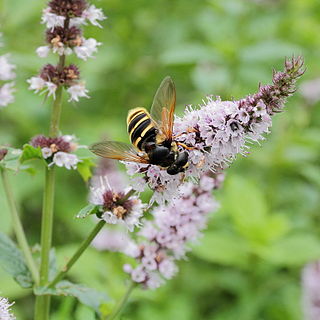
Mentha is a genus of plants in the family Lamiaceae. The exact distinction between species is unclear; it is estimated that 13 to 24 species exist. Hybridization occurs naturally where some species range overlap. Many hybrids and cultivars are known.
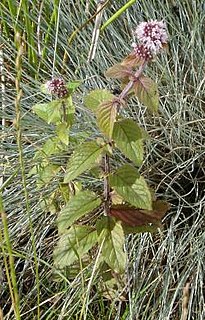
Mentha aquatica is a perennial flowering plant in the mint family Lamiaceae. It grows in moist places and is native to much of Europe, northwest Africa and southwest Asia.
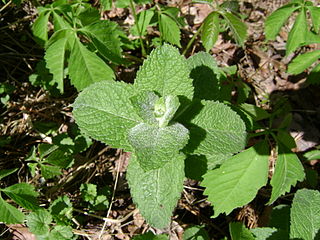
Mentha suaveolens, the apple mint, pineapple mint, woolly mint or round-leafed mint, is a member of the mint family Lamiaceae. It is native to southern and western Europe including the Mediterranean region. It is a herbaceous, upright perennial plant that is most commonly grown as a culinary herb or for ground cover.

Mentha arvensis, the corn mint, field mint, or wild mint, is a species of flowering plant in the mint family Lamiaceae. It has a circumboreal distribution, being native to the temperate regions of Europe and western and central Asia, east to the Himalaya and eastern Siberia, and North America. Mentha canadensis, the related species, is also included in Mentha arvensis by some authors as two varieties, M. arvensis var. glabrata Fernald and M. arvensis var. piperascens Malinv. ex L. H. Bailey.

Mentha canadensis is a species of mint native to North America and the eastern part of Asia. In North America, it is commonly known as Canada mint, American wild mint, and in Asia as Chinese mint, Sakhalin mint, Japanese mint, and East Asian wild mint. The flowers are bluish or have a slight violet tint. The plant is upright, growing to about 4–18 in (10–46 cm) tall. Leaves grow opposite from each other, and flower bunches appear in the upper leaf axils. The mint grows in wet areas but not directly in water, so it will be found near sloughs, and lake and river edges. Plants bloom from July to August in their native habitats.
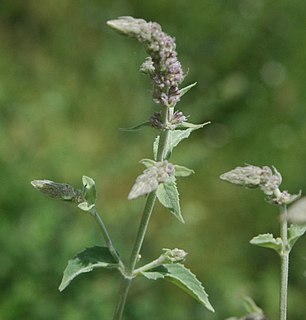
Mentha longifolia var. asiatica is known by the common name Asian mint. It is a variety of the mint species Mentha longifolia. It has also been treated as the separate species, Mentha asiatica and Mentha vagans.

Epipremnum is a genus of flowering plants in the family Araceae, found in tropical forests from China, the Himalayas, and Southeast Asia to Australia the western Pacific. They are evergreen perennial vines climbing with the aid of aerial roots. They may be confused with other Monstereae such as Rhaphidophora, Scindapsus and Amydrium.

Blainvillea is a genus of flowering plants in the aster family, Asteraceae. They are native to tropical and subtropical regions of Africa, Australia, and Latin America.
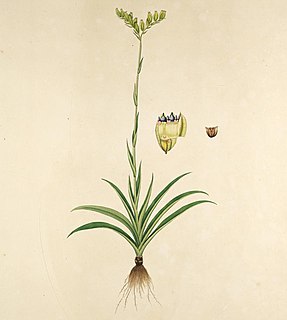
BurmannialesMart. was an order of monocotyledons, subsequently discontinued.

The production of fenugreek in India is marked by its dominant position in world production and export. Within India Rajasthan accounts for its largest cropped area and production. The fenugreek plant is an annual herbaceous forage legume with aroma, which is used for food in the form of its seeds as spices, and its leaves as a vegetable. It is also used as a medicinal herb in several Ayurvedic formulations for treatment of dry skin, boils, hair loss and so forth.

Anogeissus acuminata is a species of tree in the Combretaceae and has been called axlewood, buttontree or Burmese-derived yon in English. It is now considered a synonym of Terminalia phillyreifolia.
Mentha darvasica is a mint species within the genus Mentha, native to Darvaz, Tajikistan. The species was recorded by Russian botanist Antonina Borissova in 1954.
Mentha alaica is a mint species within the genus Mentha, native to the Pamir-Alay mountain range within Tajikistan and Kyrgyzstan. The species was recorded by Russian botanist Antonina Borissova in 1954.
Suaeda monoica is a species of flowering plant in the sea-blite genus Suaeda, largely native to the shores of the Indian Ocean from South Africa to Sri Lanka, and salty areas inland. It has been introduced in Argentina. It exhibits phenotypic plasticity, with leaves that are much more succulent when grown under higher salinity conditions. Its leaves are edible, and it is used as an animal fodder plant where it grows.

Mentha cunninghamii, known commonly as New Zealand mint or Māori mint, is a species within the Mentha (mint) genus, endemic to four islands in New Zealand.
Mentha royleana, is a species within the Mentha (mint) genus, native to eastern Afghanistan, Pakistan, the Himalayas and Kashmir. A polymorphic perennial herb, M. royleana has seen diverse uses in traditional medicine.

Mentha gattefossei is a plant species in the genus Mentha, endemic to the Atlas Mountains of Morocco. It was first described by French botanist René Maire in 1922. Harvested for its essential oil, M. gattefossei has seen use in traditional medicine, pest control and as a food seasoning.
Mentha japonica, is a plant species in the genus Mentha, endemic to the islands of Hokkaido and Honshu, Japan. Initially described as Micromeria japonica by Friedrich Anton Wilhelm Miquel, it was first identified under its present name by Japanese botanist Tomitaro Makino in 1906. A relatively rare plant, it is classified by the Japanese Ministry of Environment as a Near Threatened species.
Mentha grandiflora, is a plant species in the genus Mentha, endemic to eastern Australia. The species was described in 1848 by botanist George Bentham. Its epithet, grandiflora, means "with large flowers."
Mentha micrantha, is a plant species in the genus Mentha, native to western Kazakhstan and southeastern Russia. The species was described in 1890 by botanist George Bentham. Its epithet, micrantha, means "with small flowers." It is unique among its genus as the only species that is an annual plant.












